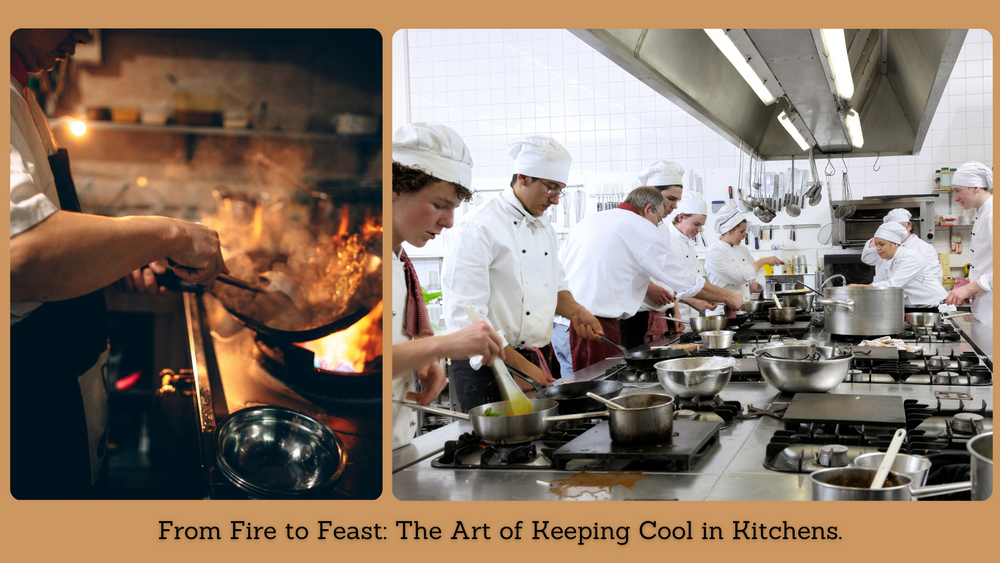"If you can't take the heat, leave the kitchen." This is more than just saying for professional chefs and line cooks - it's real and literal. The high temperature in a restaurant kitchen often exceeds with simmering liquids, hot pans, frying, and steaming that adds to the sweltering environment. Chefs face many challenges during the long working hours – staying cool under the intense heat is one of them. It's not just physical comfort but also safety, efficiency, and creativity of these culinary professionals without compromising on the quality, hygiene, and taste. Now, you might think, how chefs manage to work in this environment? Professional chefs employ different strategies to stay calm and composed, ensuring smooth and seamless operations and creating delicacies. Would you like to know what these heat-beating strategies are? This post answers the same in detail. So, stay tuned.
8 Proven Strategies for Professional Chefs to Stay Cool Amidst the Kitchen Chaos
Here are some helpful strategies to bear the heat in a busy kitchen environment.
1.Kitchen Design and Ventilation: This is one of the great ways to manage heat in a kitchen. Today, most professional kitchens are designed thoughtfully and have adequate ventilation. This helps extract hot air and bring in cooler air, significantly reducing ambient temperatures. Features like exhaust fans over each cooking station and air curtains at doorways help maintain a flow of air that mitigates the stifling heat produced by ovens, stoves, and grills.
2.High-Quality, Breathable Chef Wear: Chef clothing goes beyond just aesthetics; it is primarily designed for functionality and comfort. Chef aprons or coats are made from breathable fabrics like cotton or specialized materials that wick away sweat. This allows the skin to breathe and helps the chef stay cool. Hats and bandanas are more than fashion statements—they help keep sweat out of the eyes and prevent hair from falling in the kitchen.
3.Regular Maintenance of Kitchen Equipment: All kitchen equipment must function normally and efficiently. Malfunctioning equipment can generate unnecessary heat and pose safety risks. Regular maintenance checks help keep everything running smoothly and efficiently, reducing the heat output from stoves, ovens, and other appliances.
4.Cooling Equipment and Gadgets: In some high-end or particularly hot environments, kitchens are equipped with additional cooling equipment like air-conditioned break rooms or portable air coolers placed strategically to cool down the hottest parts of the kitchen. Innovative gadgets like cooling towels, which, when dampened, provide a cooling effect to the chef's body when worn around the neck or on the head, are also available.
5.Hydration and Nutrition: The importance of hydration is certainly not overrated, especially during the long kitchen hours. Staying hydrated is crucial , and hence all the professionals working in such hot kitchens must drink plenty of water throughout their shifts to replace fluids lost to sweating. Some kitchens keep electrolyte-replenishing beverages available to help maintain balance. Nutrition also has a key role; eating light meals that are rich in fruits and vegetables can prevent chefs from feeling sluggish and help them maintain their energy levels throughout a demanding shift.
6.Strategic Workflows and Breaks: Efficient kitchen management systems involve organizing the workflow to minimize unnecessary heat exposure. For example, tasks that require less exposure to heat sources, like plating or prep work, might be allocated during the peak heat times. Moreover, scheduling regular breaks for kitchen staff not only complies with labor laws but is also a good practice to let them cool down, which can prevent heat exhaustion and maintain productivity.
7.Mental Resilience and Training: Staying cool in the kitchen isn't just about physical comfort but also mental composure. Chefs are trained to handle the pressure of a busy kitchen. Their training includes coping mechanisms for stress and heat, such as mindfulness techniques, stress management training, or simply fostering a positive, supportive team environment where everyone looks after each other.
8.Community and Peer Support: Chefs can rely on a supportive community within the kitchen. Senior chefs might mentor younger staff, teaching them tricks and techniques to stay cool and manage the physical demands of the job. This peer support is invaluable in creating a kitchen culture that values safety, efficiency, and mutual respect.
By combining these strategies, chefs can beat the heat and keep themselves cool. They ensure that the kitchen heat won't compromise their creativity and culinary skills, leading to better working conditions. Among all these strategies, investing in quality chef wear helps goes a long way in mitigating heat and offering comfort. Commercial kitchen owners and professional chefs can benefit by sourcing good-quality chef clothing from trusted sources like ChefsCloset. The company offers extensive collections of chef clothing, including chef aprons, chef hats, chef jackets, and chef pants in varied, sizes, patterns, colors, and so on. They also offer custom options. You can contact our team to discuss your requirements.

